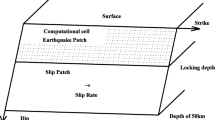Summary
Computer Simulation of Second Order Faults
Faults of the second order can be simulated in the computer with an accuracy hitherto unknown, by using Malina's (1969, 1970) program version of the Finite Element Method. The computations show that stress rearrangements occur with shear movements along the principal fault and with propagation of the fault. These stress rearrangements contribute to the development of new secondary faults. The computed second order faults can be classified according to Chinnery (1966) as shear plane typesA, B, E, andF. Moreover, the computation shows two dominant shear planes which cannot be classified according to Chinnery.
Zusammenfassung
Simulation von Störungen zweiter Ordnung im Computer
Störungen zweiter Ordnung lassen sich mit einer bisher noch nicht gekannten Genauigkeit mit Hilfe einer von Malina (1969, 1970) entwickelten Programmversion der Finite-Element-Methode im Computer simulieren. Die Rechnungen zeigen, daß mit einer Scherbewegung entlang der Hauptstörung und dem Weiterreißen der Störung Spannungsumlagerungen einhergehen, die mitbewirken, daß neue sekundäre Störungen entstehen. Die ermittelten Störungen zweiter Ordnung lassen sich nach der Klassifikation von Chinnery (1966) als die ScherflächentypenA, B, E undF einordnen. Darüberhinaus liefert die Rechnung zwei sehr häufig auftretende Scherflächen, die sich nach Chinnery nicht klassifizieren lassen.
Résumé
Simulation de failles de deuxième ordre par l'ordinateur
Les failles de deuxième ordre peuvent être simulées avec une précision encore jamais atteinte grâce à l'utilisation d'une version d'une programme développé par Malina (1969, 1970) à partir de la méthode des éléments finis. Le calcul montre que, conjointement au cisaillement le long de la faille principale et à la propagation de cette faille, de nouvelles redistributions des contraintes apparaissent. Ces nouvelles redistributions contribuent essentiellement au développement de nouvelles surfaces de failles secondaires. Les failles de deuxième ordre peuvent être classées d'après Chinnery (1966) suivant les catégories de surfaces de cisaillementA, B, E, etF. De plus, le calcul indique fréquemment deux autres types de surfaces de cisaillement n'entrant pas dans la classification de Chinnery.
Similar content being viewed by others
References
Anderson, E. M.: Dynamics of faulting and dyke formations with application to Britain. 1–206, Edinburgh (Oliver & Boyd) 1951.
Bieniawski, Z. T.: Mechanism of brittle fracture of rock. Int. J. Rock Mech. Min. Sci.4 395–430, 1967.
Chinnery, M. A.: Second faulting I. Theoretical aspects; II. Geological aspects. J. Earth Sci. Canada3 163–190, 1966.
Clark, S. P.: Handbook of physical constants. Geol. Soc. Amer. Memoirs97 1–587, 1966.
Gramberg, J.: The ellipse-with-notch theory to explain axial cleavage fracturing of rocks. Int. J. Rock Mech. Min. Sci.7 537–559, 1970.
Hoek, E., and Z. T. Bieniawski: Fracture propagation mechanism in hard rock. Proc. 1st Congr. Int. Soc. Rock Mech. Vol. 1, 243–249, 1966.
Inglis, C. E.: Stresses in a plate due to the presence of cracks and sharp corners. Inst. Naval Archit. Transact.55 219–230, 1913.
Lajtai, E. Z.: Brittle fracture in direct shear and the development of second order faults and tension gashes. Proc. Conf. Research in Tectonics, Geol. Soc. Canada,68-52 96–112, 1969.
Malina, H.: Berechnung von Spannungsumlagerungen in Fels und Boden mit Hilfe der Elementenmethode. Veröff. Inst. Bodenmech. u. Felsmech., Univ. Karlsruhe,40 1–89, 1969.
Malina, H.: The Numerical Determination of Stresses and Deformations in Rock Taking into Account Discontinuities. Rock Mech.2 1–16, 1970.
McKinstry, H. E.: Shears of second order. J. Amer. Sci.251 410–414, 1953.
Moody, J. D., and M. J. Hill: Wrench-fault tectonics. Bull. Geol. Soc. Amer.67 1207–1246, 1956.
Müller, L.: Geomechanische Auswirkungen von Abtragungsvorgängen. Geol. Rdsch.59 163–178, 1969.
Price, N. J.: Fault and joint development in brittle and semi-brittle rock. 1–176, London (Pergamon) 1966.
Price, N. J.: A dynamic mechanism for the development of second order faults. Proc. Conf. Research in Tectonics, Geol. Soc. Canada68-52 49–71, 1969.
Wilson, E. L.: Analysis of plane stress structures, Computer programming series, Program for Arbitrary Two-dimensional stress structures. Short course on the Finite Element Method in Structural Mechanics, 1967.
Author information
Authors and Affiliations
Additional information
With 11 Figures
Rights and permissions
About this article
Cite this article
Bock, H. Computer simulation of second order faults. Rock Mechanics 3, 225–238 (1971). https://doi.org/10.1007/BF01238182
Received:
Issue Date:
DOI: https://doi.org/10.1007/BF01238182




